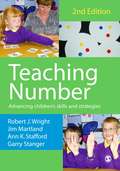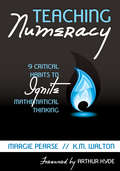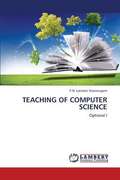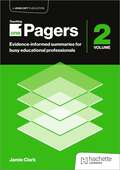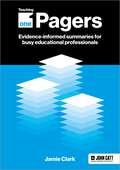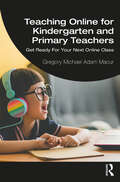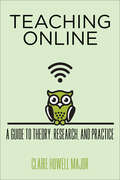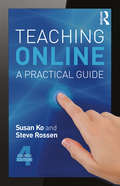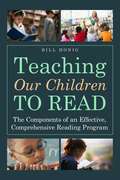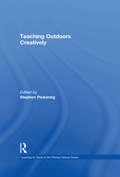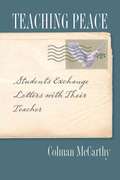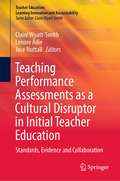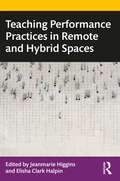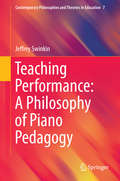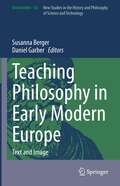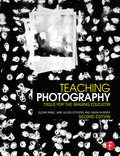- Table View
- List View
Teaching Number: Advancing Children′s Skills and Strategies (Math Recovery)
by Garry Stanger Ann K Stafford Robert J Wright James MartlandThe book lets teachers identify where their students are in terms of number skills, and sets out a strategy for developing their knowledge. The authors show how to advance children′s learning across five stages of early arithmetical learning - emergent, perceptual, figurative, initial number, and facile number. This provides for increasingly sophisticated number strategies across addition, subtraction, multiplication and division, as well as developing children′s number word and numeral knowledge, and their ability to structure number and have grouping strategies. The approach used nine guiding principles for teaching. Each chapter has clearly defined teaching procedures which show how to take the children onto the next more sophisticated stage. The teaching procedures are organized into key teaching topics, and each includes: a clearly defined purpose detailed instructions, activities, learning tasks and reinforcing games lists of responses which children may make application in whole class, small group and individualised settings a link to the Learning Framework in Number (see Early Numeracy- second edition, 2005) how the guiding principles for teaching can be used to allow teachers to evaluate and reflect upon their practice Primary practitioners in Australia, the United States, the United Kingdom and Canada have tested the teaching procedures which can be used in conjunction with each country′s numeracy strategy. Primary teachers, especially of the early years, mathematics co-ordinators, heads of school, mathematics advisers, special educationalists, learning support personnel, teacher assistants, lecturers in initial teacher training and educational psychologists will all find this book invaluable.
Teaching Numeracy: 9 Critical Habits to Ignite Mathematical Thinking
by Margaret M. Pearse Kathleen M. WaltonTransform mathematics learning from “doing” to “thinking” American students are losing ground in the global mathematical environment. What many of them lack is numeracy—the ability to think through the math and apply it outside of the classroom. Referencing the new common core and NCTM standards, the authors outline nine critical thinking habits that foster numeracy and show you how to: Monitor and repair students’ understanding Guide students to recognize patterns Encourage questioning for understanding Develop students’ mathematics vocabulary Included are several numeracy-rich lesson plans, complete with clear directions and student handouts.
Teaching Of Computer Science
by P.N. Lakshmi ShanmugamThis book has been written as a basic textbook for B.Ed student teachers who have chosen one of the optional subjects as computer science -I studying in the B.Ed colleges affiliated to Tamil Nadu Teachers Education University. The importance of systematic and organized knowledge can hardly be exaggerated in this book. Ten chapters namely Hardware and Software, Aims of Teaching Computer Science, Micro-teaching, Lesson Plan and Unit Plan, Methods of Teaching. Teaching Aids. Curriculum, Evaluation in Education, Textbook, Assignment and Review are described in a simple language with images and necessary illustrations to enable the student teachers to understand it clearly and easily. It highlights skills and values for everyday use based upon Bloom's taxonomy of educational objectives. A complete and detailed description of computer science library is helpful to the students in stimulating the ideas about digital library. Greater emphasis is given to the use of different types of tests and construction of Achievement test towards the improvement of learning and instruction.
Teaching Of Computer Science
by P.N. Lakshmi ShanmugamThis book has been written as a basic textbook for B.Ed student teachers who have chosen one of the optional subjects as computer science -I studying in the B.Ed colleges affiliated to Tamil Nadu Teachers Education University. The importance of systematic and organized knowledge can hardly be exaggerated in this book. Ten chapters namely Hardware and Software, Aims of Teaching Computer Science, Micro-teaching, Lesson Plan and Unit Plan, Methods of Teaching. Teaching Aids. Curriculum, Evaluation in Education, Textbook, Assignment and Review are described in a simple language with images and necessary illustrations to enable the student teachers to understand it clearly and easily. It highlights skills and values for everyday use based upon Bloom's taxonomy of educational objectives. A complete and detailed description of computer science library is helpful to the students in stimulating the ideas about digital library. Greater emphasis is given to the use of different types of tests and construction of Achievement test towards the improvement of learning and instruction.
Teaching Of English
by S. ParthibanEnglish, in India, is mainly taught as a second language. Hence, the aim of this book is to familiarise the students with the importance of learning English as a second language. Also it focuses on establishing English as a world, official, link and library language.
Teaching Of Social Science
by FranciskaSocial Science is a subject of study at the secondary school level which offers a systematic study of man in relation to his society. It is quite important because it is an unending dialogue between past and present which would help the nation to mould a better future.
Teaching One-Pagers 2: Evidence-informed summaries for busy educational professionals
by Jamie ClarkIt is no secret that educators are overloaded. Constantly juggling the daily demands of the profession often leaves little time for meaningful professional development. One-pagers are super-concise A4 summaries that distil key educational research, helping busy teachers reflect on their practice, build knowledge, and engage in wider reading. Building on the success of Teaching One-Pagers, Jamie Clark returns with his second visual compendium, featuring three fresh and insightful Collections. Inspired by Tom Sherrington's seminal book The Learning Rainforest, this volume delves into cultivating a thriving school culture while expertly blending Mode A and Mode B teaching practices.
Teaching One-Pagers: Evidence-informed summaries for busy educational professionals
by Jamie ClarkAsk any teacher and they would say workload is one of the biggest blockers to their professional development. Simply put, most teachers are time-poor and too busy to engage with educational research to improve their classroom instruction. One-pagers are ultra-concise, A4-sized summaries that share important ideas about good teaching. In this practical volume, Jamie Clark presents more than 55 evidence-informed one-pagers that help educators reflect on their practice, build pedagogical knowledge, and prompt professional conversations with colleagues.
Teaching Online for Kindergarten and Primary Teachers: Get Ready For Your Next Online Class
by Gregory Michael MacurThis practical guide to online teaching is for kindergarten teachers and primary or elementary teachers. It is based on research, teacher interviews, and the author’s real-world experience working in online education, as both a teacher and a trainer. Macur signposts relevant research and gives examples of key themes, tools, and ideas that can be applied in everyday teaching. These include a range of fundamental aspects of the online environment, with chapters covering online platforms, classroom management, student engagement, and feedback. It offers tried-and-tested exercises, takeaways, and reflective questions to give the reader numerous moments to consider how they will use, adapt, and develop these tools and integrate them into their own teaching practice. Teaching Online for Kindergarten and Primary Teachers is a clear, informative, and pragmatic book for all educators and students to deepen their knowledge and prepare them for teaching online and delivering effective online education like a professional.
Teaching Online: A Guide to Theory, Research, and Practice (Tech.edu: A Hopkins Series on Education and Technology)
by Claire Howell MajorDemystifies online teaching for both enthusiastic and wary educators and helps faculty who teach online do their best work as digital instructors.It is difficult to imagine a college class today that does not include some online component—whether a simple posting of a syllabus to course management software, the use of social media for communication, or a full-blown course offering through a MOOC platform. In Teaching Online, Claire Howell Major describes for college faculty the changes that accompany use of such technologies and offers real-world strategies for surmounting digital teaching challenges.Teaching with these evolving media requires instructors to alter the ways in which they conceive of and do their work, according to Major. They must frequently update their knowledge of learning, teaching, and media, and they need to develop new forms of instruction, revise and reconceptualize classroom materials, and refresh their communication patterns. Faculty teaching online must also reconsider the student experience and determine what changes for students ultimately mean for their own work and for their institutions. Teaching Online presents instructors with a thoughtful synthesis of educational theory, research, and practice as well as a review of strategies for managing the instructional changes involved in teaching online. In addition, this book presents examples of best practices from successful online instructors as well as cutting-edge ideas from leading scholars and educational technologists. Faculty members, researchers, instructional designers, students, administrators, and policy makers who engage with online learning will find this book an invaluable resource.
Teaching Online: A Practical Guide (College Teaching Ser.)
by Susan Ko Steve RossenTeaching Online: A Practical Guide is an accessible, introductory, and comprehensive guide for anyone who teaches online. The fourth edition of this bestselling resource has been fully revised, maintains its reader-friendly tone, and offers exceptional practical advice, new teaching examples, faculty interviews, and an updated resource section. New to this edition: entire new chapter on MOOCs (massive open online courses); expanded information on teaching with mobile devices, using open educational resources, and learning analytics; additional interviews with faculty, case studies, and examples; spotlight on new tools and categories of tools, especially multimedia. Focusing on the "hows" and "whys" of implementation rather than theory, the fourth edition of Teaching Online is a must-have resource for anyone teaching online or thinking about teaching online.
Teaching Our Children to Read: The Components of an Effective, Comprehensive Reading Program
by Bill HonigStudies of effective teaching practices have continued to validate the need for explicit and systematic instruction in basic reading skills, and Bill Honig uses this research to shed new light on an old problem-how to help all students become fluent readers. Teaching Our Children to Read grows out of the experiences of scores of dedicated teachers and their success in the classroom. This book explores current research from the leading experts in the field, and presents new instructional strategies that bring all students to higher levels of literacy.Highlights from Teaching Our Children to Read include: Phonics instruction and fluency Connected practice with decodable text Multisyllabic word instruction Spelling, vocabulary, and concept development Strategic reading, book discussions, and text organization Literacy benchmarks, assessment, and interventionThis is an essential resource for educators, administrators, policymakers, and parents concerned about how to successfully teach our children to read. Teaching Our Children to Read points the way to implementing the best research-based practices in adopting reading materials, training teachers, and providing the necessary school leadership.
Teaching Outdoors Creatively (Learning to Teach in the Primary School Series)
by Stephen PickeringTeaching Outdoors Creatively offers guidance and a variety of exciting ideas to suit the full range of primary schools and locations. Underpinned by current research and practical experience, it investigates innovative approaches to working creatively with children beyond the classroom. While recognising the diverse needs and opportunities that primary schools have to develop the outdoors as part of their curriculum, it presents a broad range of activities, philosophies and approaches. Key themes explored include: Understanding and using local and home environments Investigating streets and buildings in your area Planning fieldwork Using rivers to inspire children Forest schools Beach schools Physical education outdoors Learning through adventure. Teaching Outdoors Creatively supports teaching and learning in a wide range of settings, from schools in rural and urban areas, to off-site outdoor education centres and residential visits. With a focus on developing effective and stimulating learning environments for children it is a must-have resource for all busy trainee and practising teachers.
Teaching Outside the Box
by Louanne JohnsonThe handbook for improving morale by managing, disciplining and motivating your studentsThis second edition of the bestselling book includes practical suggestions for arranging your classroom, talking to students, avoiding the misbehavior cycle, and making your school a place where students learn and teachers teach. The book also contains enlivening Q&A from teachers, letters from students, and tips for grading. This new edition has been expanded to include coverage of the following topics: discipline, portfolio assessments, and technology in the classroom.Includes engaging questions for reflection at the end of each chapterJohnson is the author of The New York Times bestseller Dangerous Minds (originally My Posse Don't Do Homework)Contains a wealth of practical tools that support stellar classroom instructionThis thoroughly revised and updated edition contains comprehensive advice for both new and experienced teachers on classroom management, discipline, motivation, and morale.
Teaching Outside the Box: How to Grab Your Students By Their Brains
by LouAnne JohnsonBring a fresh perspective to your classroom Teaching Outside the Box: How to Grab Your Students by Their Brain, Third Edition integrates practical strategies and engaging advice for new and experienced teachers. Whether you are preparing for your first year of teaching or have been working in the classroom for decades, this conversational book provides you with answers to the essential questions that you face as an educator—how to engage students, encourage self-directed learning, differentiate instruction, and create dynamic lessons that nurture critical thinking and strategic problem solving. This updated edition includes expanded material that touches on Project-Based Learning, brain-based teaching, creating smooth transitions, integrating Common Core into the classroom, and other key subject areas. Questions for reflection at the end of each chapter help you leverage this resource in book groups, professional development courses, and in both undergraduate and graduate classes. The art of teaching is one that evolves with changing educational standards and best practices; to be the most effective teacher possible, daily self-reflection is critical, along with a need to see things from a different perspective. This means we must step outside the box—moving our focus from 'fixing' the students when a problem arises to helping a teacher improve his or her practice. Improve classroom management, discipline, motivation, and morale Explore strategies for arranging your classroom, engaging students, and avoiding the misbehavior cycle Create an environment where students learn and teachers teach Leverage insight from teachers and students Teaching Outside the Box: How to Grab Your Students by Their Brain, Third Edition is an essential resource for teachers at any stage in their careers.
Teaching Outside the Lines: Developing Creativity in Every Learner
by Douglas A. JohnsonMake Creativity The Center Of The Curriculum! In our fast-changing world, the ability to think independently and innovatively is no longer a “nice extra”—it’s a survival skill. This book delivers surefire strategies for equipping learners across all grades and subjects with the motivation and critical thinking skills to thrive in our high-tech future. Content includes: Why “one right answer” instruction paradigms discourage critical thinking and risk-taking Why merely using the latest technology class does not equate to teaching creatively Projects and prompts that ask the question “So what does this mean in the classroom today?”
Teaching Outside the Lines: Developing Creativity in Every Learner
by Douglas A. JohnsonMake Creativity The Center Of The Curriculum! In our fast-changing world, the ability to think independently and innovatively is no longer a “nice extra”—it’s a survival skill. This book delivers surefire strategies for equipping learners across all grades and subjects with the motivation and critical thinking skills to thrive in our high-tech future. Content includes: Why “one right answer” instruction paradigms discourage critical thinking and risk-taking Why merely using the latest technology class does not equate to teaching creatively Projects and prompts that ask the question “So what does this mean in the classroom today?”
Teaching Peace and Conflict: The Multiple Roles of School Textbooks in Peacebuilding
by Catherine Vanner Spogmai Akseer Thursica Kovinthan LeviThis book illustrates the multiple roles of textbooks as victim, transformer, and accomplice to conflict by introducing the Intersecting Roles of Education in Conflict (IREC) framework for use in the research, development, production, distribution, and dissemination of textbooks and learning materials. The framework illustrates these three potentially overlapping roles by mapping the complex educational contexts of conflict-affected societies and considering how textbooks, learning materials, and education systems more broadly may simultaneously operate within these various roles. Country case studies from Asia, Europe, Africa, and the Middle East are used to analyze primary and secondary school textbook development, content, and application from a variety of approaches that articulate conflict as protracted and/or socio-political violence. The breadth of case studies shows how conflict discourse circulates in educational systems and materials in a wide range of contexts, indicating that the complexity of the relationship between textbooks and conflict is not unique to one culture, geographic region, or type of conflict.
Teaching Peace: Students Exchange Letters with Their Teacher
by Colman McCarthyTo see if nonviolence could be taught, in 1982 Colman McCarthy became a volunteer teacher at one of the poorest high schools in Washington, DC. In the thirty-two years since then, he has taught peace studies courses for more than ten thousand college and high school students. Large numbers of those students have faithfully kept in touch with McCarthy, often with handwritten letters, and he has answered them with the same seriousness he brought to his columns and books. The exchanges rise to a rare kind of literature that blends personal warmth, intellectual honesty, and shared idealism.The discussions range from peace and war to a host of other issues of social justice, such as the death penalty, human rights, poverty, the living wage, animal rights, and vegetarianism. The wide-ranging letters suggest how teacher and students co-create a world of more love and less hate.
Teaching Peace: Students Exchange Letters with Their Teacher
by Colman McCarthyTo see if nonviolence could be taught, in 1982 Colman McCarthy became a volunteer teacher at one of the poorest high schools in Washington, DC. In the thirty-two years since then, he has taught peace studies courses for more than ten thousand college and high school students. Large numbers of those students have faithfully kept in touch with McCarthy, often with handwritten letters, and he has answered them with the same seriousness he brought to his columns and books. The exchanges rise to a rare kind of literature that blends personal warmth, intellectual honesty, and shared idealism. The discussions range from peace and war to a host of other issues of social justice, such as the death penalty, human rights, poverty, the living wage, animal rights, and vegetarianism. The wide-ranging letters suggest how teacher and students co-create a world of more love and less hate.
Teaching Performance Assessments as a Cultural Disruptor in Initial Teacher Education: Standards, Evidence and Collaboration (Teacher Education, Learning Innovation and Accountability)
by Claire Wyatt-Smith Joce Nuttall Lenore AdieThis book explores how well teachers are prepared for professional practice. It is an outcome of a large-scale research and development program that has collected extensive data on the impact of the Graduate Teacher Performance Assessment on Initial Teacher Education programs and preservice teachers’ engagement with the assessment. It contributes to international debates in teacher education by examining an Australian experience of teacher performance assessments as a catalyst for cultural change and practice reform in teacher education. The respective chapters describe and critique this unique, multi-institutional investigation into the quality of teacher education and present substantial evidence, drawing on a variety of conceptual, empirical and methodological entry points. Further, they address the intellectual, experiential and personal resources and related expertise that teacher educators and preservice teachers bring to their practice. Taken together, they offer readers clearly conceptualised and evidence-rich accounts of site-specific and cross-site investigations into cultural, pedagogical and assessment change in Initial Teacher Education.
Teaching Performance Practices in Remote and Hybrid Spaces
by Jeanmarie HigginsThis collection of insightful essays gives teachers’ perspectives on the role of space and presence in teaching performance. It explores how the demand for remote teaching can be met while at the same time successfully educating and working compassionately in this most ‘live’ of disciplines. Teaching Performance Practices in Remote and Hybrid Spaces reframes prevailing ideas about pedagogy in dance, theatre, and somatics and applies them to teaching in face-to-face, hybrid, and remote situations. Case studies from instructors and professors provide essential, practical suggestions for remotely teaching a vast range of studio courses, including tap dance, theatre design, movement, script analysis, and acting, rendering this book an invaluable resource. The challenges that teachers are facing in the early twenty-first century are addressed throughout, helping readers to navigate these unprecedented circumstances whilst delivering lessons, guiding workshops, rehearsing, or even staging performances. This book is invaluable for dance and theatre teachers or leaders who work in the performing arts and related disciplines. It is also ideal for any professionals who need research-based solutions for teaching performance online.
Teaching Performance: A Philosophy of Piano Pedagogy
by Jeffrey SwinkinHow can the studio teacher teach a lesson so as to instill refined artistic sensibilities, ones often thought to elude language? How can the applied lesson be a form of aesthetic education? How can teaching performance be an artistic endeavor in its own right? These are some of the questions Teaching Performance attempts to answer, drawing on the author's several decades of experience as a studio teacher and music scholar. The architects of absolute music (Hanslick, Schopenhauer, and others) held that it is precisely because instrumental music lacks language and thus any overt connection to the non-musical world that it is able to expose essential elements of that world. More particularly, for these philosophers, it is the density of musical structure--the intricate interplay among purely musical elements--that allows music to capture the essences behind appearances. By analogy, the author contends that the more structurally intricate and aesthetically nuanced a pedagogical system is, the greater its ability to illuminate music and facilitate musical skills. The author terms this phenomenon relational autonomy. Eight chapters unfold a piano-pedagogical system pivoting on the principle of relational autonomy. In grounding piano pedagogy in the aesthetics of absolute music, each domain works on the other. On the one hand, Romantic aesthetics affords pedagogy a source of artistic value in its own right. On the other hand, pedagogy concretizes Romantic aesthetics, deflating its transcendental pretentions and showing the dichotomy of absolute/utilitarian to be specious.
Teaching Philosophy in Early Modern Europe: Text and Image (Archimedes #61)
by Daniel Garber Susanna BergerThis book examines how philosophy was taught in the early modern period in Europe. It breaks new ground in a number of ways. Firstly, it seeks to bring text-based scholars in the history of philosophy together with social and cultural historians to examine the interaction between tradition and innovation in the early modern classroom, the site where traditional views of the world were transmitted to the generation that was to give birth to modern philosophy and science. Secondly, it draws together scholars who are centered on ideas and words with other scholars who focus on the role of images in the classroom and the intellectual world in this central period of history. The volume advances our understanding of how philosophy was understood and transmitted in this rich and crucial era. The principal audience for Teaching Philosophy are historians of science, philosophy, art, visual culture, and print culture. The chapters are written in a tone accessible to upper-level undergraduates and graduate students. It also reaches non-specialist readers interested in subjects including the “scientific revolution,” the organization of information, and Renaissance and Baroque visual art.
Teaching Photography: Tools for the Imaging Educator (Photography Educators Series)
by Glenn Rand Garin Horner Jane Alden StevensThe photographic community is rife with talented and creative practitioners and artists. But making great photographs does not always translate into an ability to teach effectively. This new edition of Teaching Photography approaches photographic education from a point of view that stresses the how and why of the education. It includes the resources that will inspire new and seasoned teachers to help students expand their technical and aesthetic abilities and techniques, as well as their visual literacy and the way photography fits into the wider world. Fully updated to include the online/hybrid classroom environment, collaborative learning, rubrics, and using digital technology, plus techniques for inspiring conversations and critiques.
